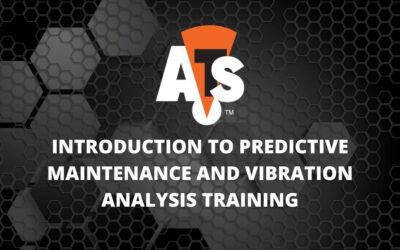<TRANSCRIPT>
Today I’ll be talking about what it takes to be successful with your condition monitoring and evaluation program.
This discussion builds from concepts I presented in previous Vidtorials that we’ve already posted on our blog.
We know that Condition Monitoring and Evaluation is primarily a Planning Tool, used to help us to identify situations in our machinery and systems that, if not corrected, would lead to functional failure and loss of valuable productivity. We use Condition Monitoring data to Detect, Diagnose, and Prognosticate what’s going on in our machines and systems, like your physician does when you go in for a physical exam.
The DETECTION aspect identifies the fact that something’s going on that’s not entirely right, the DIAGNOSIS phase is where we interpret the data to get an understanding of what’s actually happening, and the PROGNOSIS stage is where we apply our understanding to determine what needs to be done to address the issue and when we should do it.
So the real question is: What are the key elements needed for a successful program?
Don’t worry, I’m not going to stand here and tell you that you need this or that specific technology to be successful.
In my experience, KNOWLEDGE and not any particular technology is what makes a program successful. The most important knowledge element is a THOROUGH UNDERSTANDING OF THE MACHINERY AND SYSTEMS, at the gut-level! You need to understand your machinery in terms of:
- The internal components that it’s made of and how they’re put together
- How it’s built and installed
- How it’s supposed to run
- How it relates to the whole production process.
You need to be like a superhero with x-ray vision – not necessarily able to leap tall buildings – but able to look at a machine and visualize its internal components, understanding what they each do, why they’re there, and how they interact with the rest of the machine or system.
If you have this gut-level understanding of the machine, then I promise that you already know intuitively BOTH:
- How it’s likely to fail in service
- How those failure mechanisms will show themselves to us when they are in progress.
At ATS, ALL of our Team Members who evaluate your data have extensive experience managing, maintaining, and monitoring machinery. We only hire folks who already have this requisite gut-level understanding of machines.
Remember, functional failure is a process. It only becomes an event based on how we react – or not – to its indications!
So with this understanding, we are in the best position to go to the next step,
and that is……………………… Methods. Having and using the right technologies and skills. It means using the right technology, or technologies, to help us recognize that one or more failure mechanisms are in progress or that some irreversible damage has already started that requires our attention.
Data needs to be collected frequently enough that we can assure ourselves that we’ll be able to see the problem developing with sufficient time to react to it.
Data needs to either be collected under consistent operating conditions, OR we need the ability to record the machine operating state with the data so that we will always know what was going on in the machine when the data was collected. We need to be able to compartmentalize the data so that we can differentiate between what is normal and what is not normal for each operating mode, speed, direction, load – or whatever – that the machine goes through during its normal operating life.
Think about your car, for a minute. You know what your car sounds like when you back out of your driveway. You also know what your car sounds like when you’re accelerating onto the interstate highway. Both sounds are different, but normal for what the car is doing at the time. If it sounded like accelerating to highway speed when pulling out of your driveway, that would be a clue that something’s not right. Unless, of course, you’re hearing it from outside the car and your teenager is the one who’s backing it out!
You also need the data collection to be thorough and able to target as many of the primary failure mechanisms as practical.
What we do with the data is also important. Evaluating condition data is more change analysis than anything else. We’re trying to understand what’s different this time compared to the last time we looked at the data. We need to understand what that data is trying to tell us. Really, your data does talk to you – you just need to be tuned in to listen to it! The final step is to be sure to enter all findings and recommendations
into the Work Management System, so that the corrective action can be properly prioritized, planned, scheduled, and have resources allocated to it. I’ve seen more cases than I’d care to count where problems were identified but corrective action wasn’t taken in time and the machine failed primarily because of a breakdown in the communication handoff.
No surprises there!
When it comes to deciding how to apply our chosen technologies, we need to think back to the concepts we discussed previously. Specifically, the anticipated time from problem detection to either damage or functional failure – the concepts we get from the extended P-F curve – AND the cost consequences of having the functional failure unexpectedly.
There are no absolutes in what I am about to describe. Your unique situation MUST be taken into consideration. That said, IN GENERAL:
- If it takes a relatively long time for a problem to progress from when it is first detectable AND/OR the cost consequences of losing the machine or system are relatively low, then it is probably a good candidate for periodic monitoring using handheld, walk-around instruments, where data is collected on approximately a monthly basis. This applies primarily to low-cost consequences, and long degradation development machines.
- As machines get higher in value, in terms of cost consequences or criticality to the operation, AND/OR the time from first indication to failure is on the order of a couple of months to a couple of weeks, then battery-powered wireless sensor systems, that collect data at intervals as low as every day or every few hours, would most likely be sufficient.
- Higher value machines, again in terms of the cost consequences of their loss or criticality to production, AND/OR they progress to failure in a week, or less, should be monitored with permanently mounted sensors, wired to permanently powered instruments that are capable of collecting data on the order of every hour to as quickly every minute.
Of course, all this data needs to be sent to a Central software or a dedicated remote monitoring center for evaluation so that timely recommendations can be made.
This is why we support all types of data collection for multiple technologies at ATS. Our goal is to help you get the most value from your investment in condition monitoring and we look at every sensor, on every monitored machine, every workday to provide recommended solutions BEFORE problems have a chance to develop out of control.






0 Comments